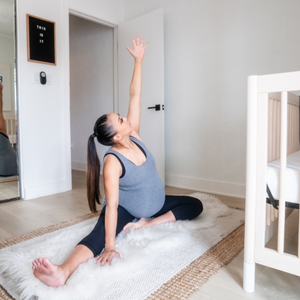
A Labor Prep Guide for Expecting Moms
FIT4MOM x Jessica Maurer
As the third trimester of pregnancy approaches, the anticipation of labor and delivery becomes more real. While it’s natural to focus on preparing the nursery and gathering all the necessary baby items, preparing your body and mind for labor is equally essential. Labor prep during the third trimester can significantly impact your experience, helping you approach the big day with confidence and strength.
This blog will explore the essential aspects of labor preparation, including breathing techniques, pelvic floor health, mobility exercises, and mental resilience.

The Role of Breathing in Labor Prep
Breathing is one of the most powerful tools you have during labor. The right breathing techniques can help manage pain, keep you focused, and ensure that both you and your baby receive adequate oxygen throughout the process. During the third trimester, practicing controlled breathing can condition your body to use these techniques instinctively during labor.
1. 360 Breathing:
360 breathing involves inhaling slowly and deeply through your nose, allowing your belly, ribs, and back to expand as you fill your lungs completely.
To feel 360-degree breathing, place one hand on your belly button and the other on your rib cage. Now, inhale; you should feel both of your hands move outward. If you only feel the belly button hand move forward, you are not fully breathing. Try again, with your intention being to expand your rib cage outward. Do you feel a difference?
This technique can help calm your nervous system, reduce stress, and increase your oxygen intake, which is crucial during labor. Practicing deep breathing during your third trimester can help you stay relaxed and focused when contractions begin.
2. Rhythmic Breathing:
Rhythmic breathing, also known as patterned breathing, involves breathing at a steady, consistent pace. This technique can be beneficial during the active phase of labor when contractions are intense. Practicing rhythmic breathing during your third trimester can help you maintain control and reduce pain perception during labor. We recommend trying our Breath Work series to learn more techniques.

Pelvic Floor Health
The pelvic floor muscles play a critical role during labor and delivery. These muscles support the uterus, bladder, and bowels, and control the release of urine and feces. Your pelvic floor is similar to a hammock. The weight of the uterus causes the hammock to stretch downward, weakening this group of muscles and causing strain. Remember, the pelvic floor is not the only muscle that connects to the pelvis, and muscles such as the glutes and lower back will also feel the strain.
Linking your breath to your pelvic floor can help you connect your mind to your pelvic floor, aiding in the pushing phase of labor. Try this exercise:
Imagine your pelvic floor is an elevator. As you exhale, close the doors and lift the elevator as you find a slight contraction in your core muscles. Now, inhale as you expand your belly, ribs and back, lower the elevator back down, and open the doors as you do so. Continue to link the breath to the pelvic floor and core activation.
Looking for another way to connect to your body? Check out this Body Scan.
Preparing Your Body for Labor
Labor is a physically demanding process that requires strength, endurance, and flexibility. In addition to strengthening the body with movements like squats, and opening the hips with movements like seated windshield wipers, mobility exercises can help alleviate some of the discomfort of the third trimester and prepare your body for labor challenges by reducing muscle tension.
Keep in mind that you need to prepare your entire body for labor, not just your hips and Incorporating the linked breathing and pelvic floor exercises listed above into your mobility exercises is extremely important.
If you are not sure how to strengthen your body throughout pregnancy, we strongly recommend joining one of our FIT4BABY programs. Find a location near you!
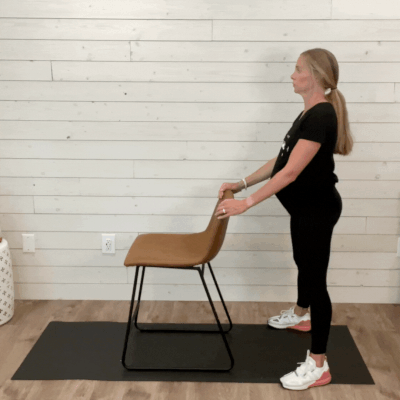
Deep Birthing Squats
Before beginning any mobility exercise, find a strong posture. Your pelvis should be as neutral as possible, with your rib cage zipped together and a proud chest. Step out slightly wider than your hips with a small external rotation. Walk down the sides of the chair with your hands as you lower into a deep squat position. Use the chair to walk back up to standing, pausing for a full pelvic floor contraction and release at the top of the movement.
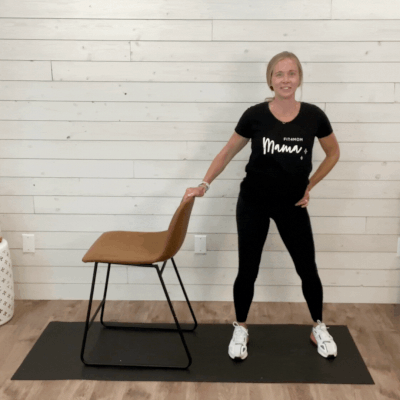
Hip Circles
For hip circles, move slowly and with intention. Do not allow your rib cage to flare open as you rotate towards the front. You are welcome to stop for a moment of stretch in any of the positions of this circle.
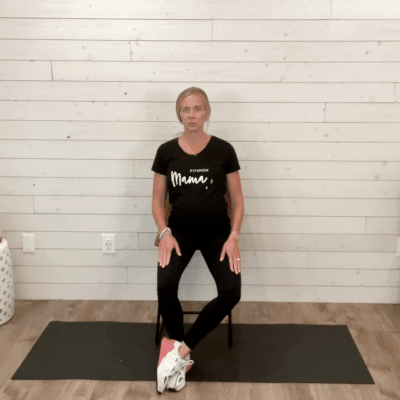
Seated Piriformis Stretch
Sit with strong posture in a chair, one foot fully connected to the floor while the other leg is crossed over the ankle. Allow the crossed leg to open to the side of the room. Support yourself with your hands on your thighs as you lean your upper body and torso forward while maintaining a strong posture and long spine. Use your hands to push yourself back to sitting upright.
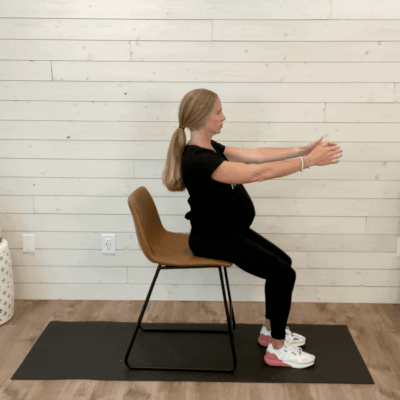
Upper Rotation & Release
While seated, lift your arms to shoulder height while rolling your shoulder blades into your back pockets. Incorporating your breath and pelvic floor (as discussed above), exhale as you rotate to one side. Inhale as you return to the starting position.
Mental Resiliency: The Mind-Body Connection in Labor
Mental resiliency is a crucial aspect of labor prep that is often overlooked. The mind-body connection plays a significant role in how you experience labor. Building mental resilience during the third trimester can help you stay calm, focused, and adaptable during the unpredictable process of childbirth.
1. Visualization:
Visualization involves mentally rehearsing your labor experience by imagining positive outcomes and successful coping strategies. Visualizing during the third trimester can help reduce anxiety and build confidence in managing labor. Visualizing your body working efficiently and your baby arriving safely can create a sense of empowerment and readiness.
2. Mindfulness and Meditation:
Mindfulness and meditation practices involve focusing on the present moment and cultivating a sense of inner calm. Regular mindfulness practice during the third trimester can help you stay grounded and reduce stress as labor approaches. Meditation techniques, such as focusing on your breath or repeating positive affirmations, can also be used during labor to maintain mental clarity and resilience.
Labor prep during the third trimester is vital to ensuring a positive and empowering childbirth experience. By focusing on breathing techniques, pelvic floor health, mobility exercises, and mental resiliency, you can use the tools to navigate labor confidently and confidently.
Remember, labor is not just a physical journey but a mental and emotional one. Preparing your body and mind during the final weeks of pregnancy can make all the difference as you embark on the incredible journey of bringing your baby into the world.
As always, we are here for you if you are looking for a village to support you through your pregnancy and motherhood journey. We offer FIT4BABY – workouts to build your mental and physical endurance, strengthen your body, and prepare you for pregnancy, birth, and beyond. Your first class is always free.
WANT TO LEARN MORE?
As a certified Prenatal and Postnatal Fitness professional, you'll enhance your career and profoundly impact the lives of expectant and new mothers. Elevate your skills, transform lives, and embark on a fulfilling career where you can merge your passion for fitness with the joy of supporting women through one of life's most remarkable experiences.
Register here to receive more information on prenatal & postnatal fitness myths.
If you liked this blog, check these out:


